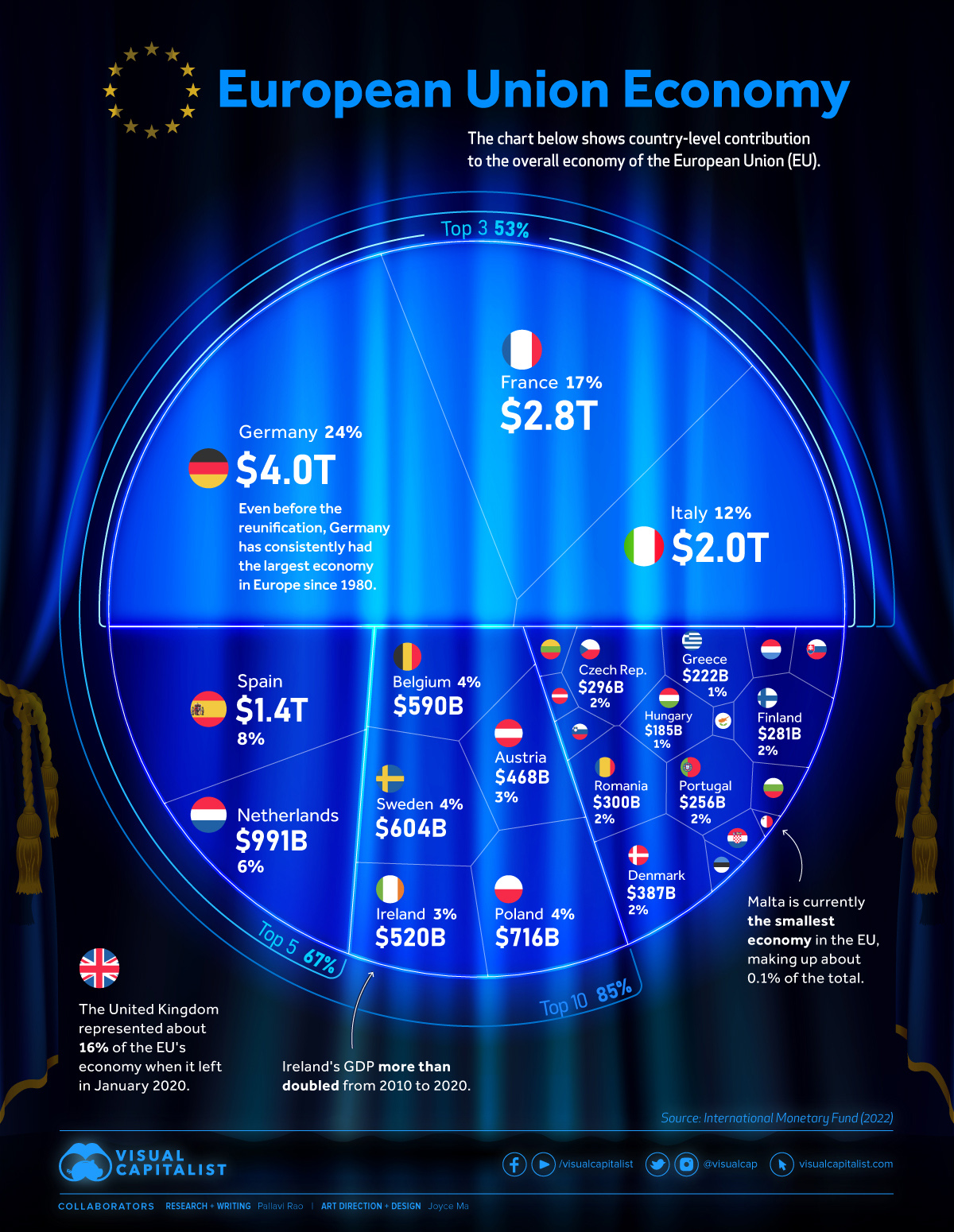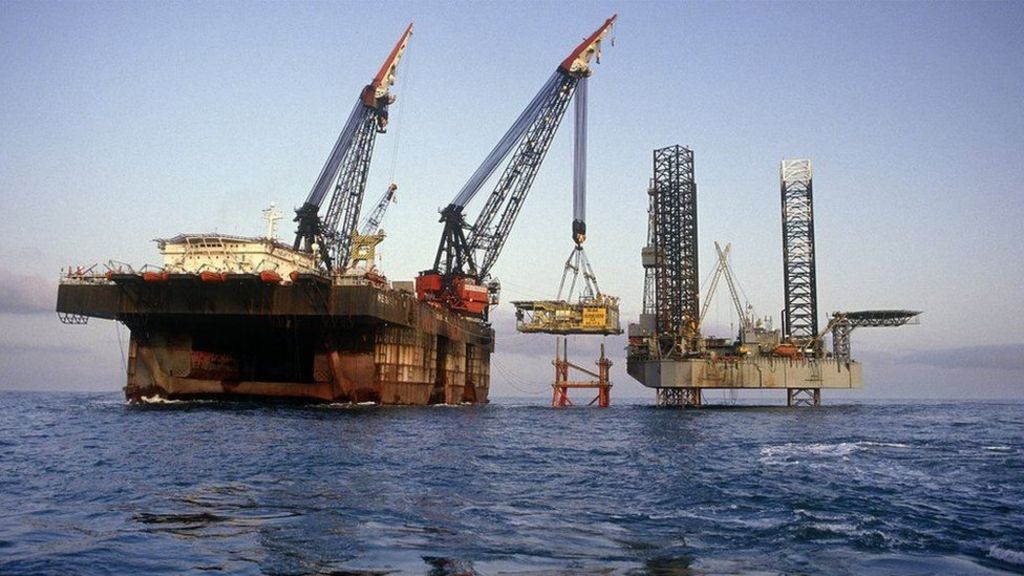Economy
The $16 Trillion European Union Economy
|
|


The European Union has the third-largest economy in the world, accounting for one-sixth of global trade. All together, 27 member countries make up one internal market allowing free movement of goods, services, capital and people.
But how did this sui generis (a class by itself) political entity come into being?
A Brief History of the EU
After the devastating aftermath of the World War II, Western Europe saw a concerted move towards regional peace and security by promoting democracy and protecting human rights.
Crucially, the Schuman Declaration was presented in 1950. The coal and steel industries of Western Europe were integrated under common management, preventing countries from turning on each other and creating weapons of war. Six countries signed on — the eventual founders of the EU.
Here’s a list of all 27 members of the EU and the year they joined.
| Country | Year of entry |
|---|---|
| 🇧🇪 Belgium | 1958 |
| 🇫🇷 France | 1958 |
| 🇩🇪 Germany | 1958 |
| 🇮🇹 Italy | 1958 |
| 🇱🇺 Luxembourg | 1958 |
| 🇳🇱 Netherlands | 1958 |
| 🇩🇰 Denmark | 1973 |
| 🇮🇪 Ireland | 1973 |
| 🇬🇷 Greece | 1981 |
| 🇵🇹 Portugal | 1986 |
| 🇪🇸 Spain | 1986 |
| 🇦🇹 Austria | 1995 |
| 🇫🇮 Finland | 1995 |
| 🇸🇪 Sweden | 1995 |
| 🇨🇾 Cyprus | 2004 |
| 🇨🇿 Czechia | 2004 |
| 🇪🇪 Estonia | 2004 |
| 🇭🇺 Hungary | 2004 |
| 🇱🇻 Latvia | 2004 |
| 🇱🇹 Lithuania | 2004 |
| 🇲🇹 Malta | 2004 |
| 🇵🇱 Poland | 2004 |
| 🇸🇰 Slovakia | 2004 |
| 🇸🇮 Slovenia | 2004 |
| 🇧🇬 Bulgaria | 2007 |
| 🇷🇴 Romania | 2007 |
| 🇭🇷 Croatia | 2013 |
Greater economic and security cooperation followed over the next four decades, along with the addition of new members. These tighter relationships disincentivized conflict, and Western Europe—after centuries of constant war—has seen unprecedented peace for the last 80 years.
The modern version of the EU can trace its origin to 1993, with the adoption of the name, ‘the European Union,’ the birth of a single market, and the promise to use a single currency—the euro.
Since then the EU has become an economic and political force to reckon with. Its combined gross domestic product (GDP) stood at $16.6 trillion in 2022, after the U.S. ($26 trillion) and China ($19 trillion.)
Front Loading the EU Economy
For the impressive numbers it shows however, the European Union’s economic might is held up by three economic giants, per data from the International Monetary Fund. Put together, the GDPs of Germany ($4 trillion), France ($2.7 trillion) and Italy ($1.9 trillion) make up more than half of the EU’s entire economic output.
These three countries are also the most populous in the EU, and together with Spain and Poland, account for 66% of the total population of the EU.
Here’s a table of all 27 member states and the percentage they contribute to the EU’s gross domestic product.
| Rank | Country | GDP (Billion USD) | % of the EU Economy |
|---|---|---|---|
| 1. | 🇩🇪 Germany | 4,031.1 | 24.26% |
| 2. | 🇫🇷 France | 2,778.1 | 16.72% |
| 3. | 🇮🇹 Italy | 1,997.0 | 12.02% |
| 4. | 🇪🇸 Spain | 1,390.0 | 8.37% |
| 5. | 🇳🇱 Netherlands | 990.6 | 5.96% |
| 6. | 🇵🇱 Poland | 716.3 | 4.31% |
| 7. | 🇸🇪 Sweden | 603.9 | 3.64% |
| 8. | 🇧🇪 Belgium | 589.5 | 3.55% |
| 9. | 🇮🇪 Ireland | 519.8 | 3.13% |
| 10. | 🇦🇹 Austria | 468.0 | 2.82% |
| 11. | 🇩🇰 Denmark | 386.7 | 2.33% |
| 12. | 🇷🇴 Romania | 299.9 | 1.81% |
| 13. | 🇨🇿 Czechia | 295.6 | 1.78% |
| 14. | 🇫🇮 Finland | 281.4 | 1.69% |
| 15. | 🇵🇹 Portugal | 255.9 | 1.54% |
| 16. | 🇬🇷 Greece | 222.0 | 1.34% |
| 17. | 🇭🇺 Hungary | 184.7 | 1.11% |
| 18. | 🇸🇰 Slovakia | 112.4 | 0.68% |
| 19. | 🇧🇬 Bulgaria | 85.0 | 0.51% |
| 20. | 🇱🇺 Luxembourg | 82.2 | 0.49% |
| 21. | 🇭🇷 Croatia | 69.4 | 0.42% |
| 22. | 🇱🇹 Lithuania | 68.0 | 0.41% |
| 23. | 🇸🇮 Slovenia | 62.2 | 0.37% |
| 24. | 🇱🇻 Latvia | 40.6 | 0.24% |
| 25. | 🇪🇪 Estonia | 39.1 | 0.24% |
| 26. | 🇨🇾 Cyprus | 26.7 | 0.16% |
| 27. | 🇲🇹 Malta | 17.2 | 0.10% |
| Total | 16,613.1 | 100% |
The top-heaviness continues. By adding Spain ($1.3 trillion) and the Netherlands ($990 billion), the top five make up nearly 70% of the EU’s GDP. That goes up to 85% when the top 10 countries are included.
That means less than half of the 27 member states make up $14 trillion of the $16 trillion EU economy.
Older Members, Larger Share
Aside from the most populous members having bigger economies, another pattern emerges, with the time the country has spent in the EU.
Five of the six founders of the EU—Germany, France, Italy, the Netherlands, Belgium—are in the top 10 biggest economies of the EU. Ireland and Denmark, the next entrants into the union (1973) are ranked 9th and 11th respectively. The bottom 10 countries all joined the EU post-2004.
The UK—which joined the bloc in 1973 and formally left in 2020—would have been the second-largest economy in the region at $3.4 trillion.
Sectoral Analysis of the EU
The EU has four primary sectors of economic output: services, industry, construction, and agriculture (including fishing and forestry.) Below is an analysis of some of these sectors and the countries which contribute the most to it. All figures are from Eurostat.
Services and Tourism
The EU economy relies heavily on the services sector, accounting for more than 70% of the value added to the economy in 2020. It also is the sector with the highest share of employment in the EU, at 73%.
In Luxembourg, which has a large financial services sector, 87% of the country’s gross domestic product came from the services sector.
Tourism economies like Malta and Cyprus also had an above 80% share of services in their GDP.
Industry
Meanwhile 20% of the EU’s gross domestic product came from industry, with Ireland’s economy having the most share (40%) in its GDP. Czechia, Slovenia and Poland also had a significant share of industry output.
Mining coal and lignite in the EU saw a brief rebound in output in 2021, though levels continued to be subdued.
| Rank | Sector | % of the EU Economy |
|---|---|---|
| 1. | Services | 72.4% |
| 2. | Industry | 20.1% |
| 3. | Construction | 5.6% |
| 4. | Agriculture, forestry and fishing | 1.8% |
Agriculture
Less than 2% of the EU’s economy relies on agriculture, forestry and fishing. Romania, Latvia, and Greece feature as contributors to this sector, however the share in total output in each country is less than 5%. Bulgaria has the highest employment (16%) in this sector compared to other EU members.
Energy
The EU imports nearly 60% of its energy requirements. Until the end of 2021, Russia was the biggest exporter of petroleum and natural gas to the region. After the war in Ukraine that share has steadily decreased from nearly 25% to 15% for petroleum liquids and from nearly 40% to 15% for natural gas, per Eurostat.
Headwinds, High Seas
The IMF has a gloomy outlook for Europe heading into 2023. War in Ukraine, spiraling energy costs, high inflation, and stagnant wage growth means that EU leaders are facing “severe trade-offs and tough policy decisions.”
Reforms—to relieve supply constraints in the labor and energy markets—are key to increasing growth and relieving price pressures, according to the international body. The IMF projects that the EU will grow 0.7% in 2023.





Economy
Russia to grow faster than all advanced economies says IMF – BBC.com


An influential global body has forecast Russia’s economy will grow faster than all of the world’s advanced economies, including the US, this year.
The International Monetary Fund (IMF) expects Russia to grow 3.2% this year, significantly more than the UK, France and Germany.
Oil exports have “held steady” and government spending has “remained high” contributing to growth, the IMF said.
Overall, it said the world economy had been “remarkably resilient”
“Despite many gloomy predictions, the world avoided a recession, the banking system proved largely resilient, and major emerging market economies did not suffer sudden stops,” the IMF said.
The IMF is an international organisation with 190 member countries. They are used by businesses to help plan where to invest, and by central banks, such as the Bank of England to guide its decisions on interest rates.
The group says that the forecasts it makes for growth the following year in most advanced economies, more often than not, have been within about 1.5 percentage points of what actually happens.
Despite the Kremlin being sanctioned over its invasion of Ukraine, the IMF upgraded its January predictions for the Russian economy this year, and said while growth would be lower in 2025, it would be still be higher than previously expected at 1.8%.
Investments from corporate and state owned enterprises and “robustness in private consumption” within Russia had promoted growth alongside strong exports of oil, according to Petya Koeva Brooks, deputy director at the IMF.
Russia is one of the world’s biggest oil exporters and in February, the BBC revealed millions of barrels of fuel made from Russian oil were still being imported to the UK despite sanctions.
Away from Russia, the IMF downgraded its forecasts across Europe and for the UK this year, predicting 0.5% growth this year, making the UK the second weakest performer across the G7 group of advanced economies, behind Germany.
The G7 also includes France, Italy, Japan, Canada and the US.
Growth is set to improve to 1.5% in 2025, putting the UK among the top three best performers in the G7, according to the IMF.
However, the IMF said that interest rates in the UK will remain higher than other advanced nations, close to 4% until 2029.
The group expects the UK to have the highest inflation of any G7 economy in 2023 and 2024.
Chancellor Jeremy Hunt said the IMF’s figures showed that the UK economy was turning a corner.
“Inflation in 2024 is predicted to be 1.2% lower than before, and over the next six years we are projected to grow faster than large European economies such as Germany or France – both of which have had significantly larger downgrades to short-term growth than the UK,” he said.
Conflict in the Middle East
Economists at the IMF warned that if the Israel-Hamas conflict escalates further in the Middle East it could lead to rising food and energy prices around the world.
Continued attacks on ships in the Red Sea and the ongoing war in Ukraine could also affect the so far “remarkably resilient” global economy, it said.
A potential spike in food, energy and transport costs would see lower-income countries hardest hit, it added.
Economy
Why is Germany maintaining economic ties with China? – Al Jazeera English


German Chancellor Olaf Scholz has been on a three-day visit to China in a bid to shore economic ties.
Germany is China’s biggest European trade partner.
But, Berlin also sees Beijing as a competitor and a rival.
And – in its first-ever “strategy on China” launched last year – pledged to reduce German dependence on the Chinese market.
But, during his visit last week to China, the German Chancellor signalled his intentions to maintain business ties.
That may have angered some of Olaf Scholz’s closest allies.
The European Union has launched several investigations into exports of Chinese green technology to protect European industry from competition.
Are Nigeria’s reforms working?
We speak to the president of the United Nations General Assembly on sustainability.
Economy
BMO chief says US economy improving, calls California ‘a strategically important market’
|
|

TORONTO (Reuters) – The U.S. economy was showing signs of stronger than expected growth, with California being a strategically important market, said the head of Bank of Montreal, which has rapidly expanded in its southern neighbour.
CEO Darryl White, addressing shareholders at the bank’s annual meeting, said the bank was well positioned to cater to clients between American and Canadian economies in a shifting global landscape.
BMO, Canada’s third largest bank by market capitalization, makes about a third of its income from the United States after its $16.3 billion Bank of the West acquisition last year, the biggest ever deal in Canadian banking history.
He said that trade and investment between Canada and the U.S. is key to economic competitiveness noting that it is one of the largest bilateral trade relationships in the world.
“The relationship is significant. Put into context, just counting the Great Lakes region… (it) would be the world’s third largest economy, nearly equal to that of Japan and Germany combined, and the region employs about a third of the U.S.-Canadian combined workforce,” he said.
“Then add in California, an economy almost twice the size of Canada’s, and you can see the global impact this North-South partnership has.”
Canadian banks are increasingly looking to expand south of the border or in other parts of the world as opportunities at home are limited in a saturated market.
White cautioned about a higher-for-longer interest rate environment as borrowing costs remain high and demand weakens. But when rates begin to ease, the market could see a “new normal, an environment with fundamentally different characteristics than that of the past two decades,” he said.
(Reporting by Nivedita Balu in Toronto; Editing by Aurora Ellis)





-



 Sports12 hours ago
Sports12 hours agoTeam Canada’s Olympics looks designed by Lululemon
-
Real eState20 hours ago
Search platform ranks Moncton real estate high | CTV News – CTV News Atlantic
-
Tech19 hours ago
Motorola's Edge 50 Phone Line Has Moto AI, 125-Watt Charging – CNET
-



 Science23 hours ago
Science23 hours agoSpace exploration: A luxury or a necessity? – Phys.org
-



 Politics17 hours ago
Politics17 hours agoPolitical interference in Canada’s pension funds is wrong
-



 Sports23 hours ago
Sports23 hours agoRECAP: Red Wings' 5-4 comeback OT victory against Canadiens the result of belief, resiliency | Detroit Red Wings – NHL.com
-
News21 hours ago
Former mayor appealing sexual assault conviction dies of cancer
-
Business11 hours ago
Firefighters battle wildfire near Edson, Alta., after natural gas line rupture – CBC.ca




